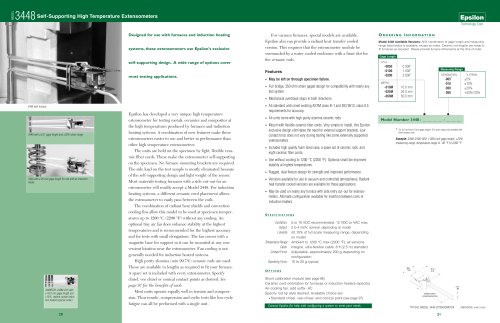 Website:
Epsilon Technology
Website:
Epsilon Technology
Catalog excerpts

ESCS Epsilon Shunt Calibration System NEW PRODUCT Designed to allow Epsilon’s extensometer calibration to be easily transferred to a customer’s electronics, the Epsilon Shunt Calibration System is available for any strain-gaged extensometer. What is shunt calibration? The Epsilon Shunt Calibration System provides an easy way to calibrate an extensometer and signal conditioning electronics without using a mechanical calibrator. Shunt calibration enables performing on-site electrical calibration with nearly all types of controllers and electronics. It also makes it easy to periodically “spot check” the calibration of the electronics, which will help ensure that the extensometer and electronics are calibrated correctly. Note that the Epsilon Shunt Calibration System does not replace the need for on-site verification using a mechanical extensometer calibrator. On-site verification is required by many labs and testing standards. Which extensometers include the Epsilon Shunt Calibration System? The Epsilon Shunt Calibration System is included with every new Epsilon strain-gaged extensometer. Customers who would like Epsilon to add the Epsilon Shunt Calibration System to an existing extensometer that does not have it can send the extensometer to Epsilon for re-calibration. Epsilon will install the Epsilon Shunt Calibration System, perform a calibration, and return the retrofitted extensometer with a new Epsilon Test Certificate. How does shunt calibration work? The Epsilon Shunt Calibration System is used for two-point calibrations. The first point is the extensometer’s gauge length. Epsilon Shunt Calibration System The second point is the shunt calibration point. When the Epsilon Shunt is plugged into the Shunt Connector, the shunt resistor, which is located in the Shunt Connector, is electrically connected across one arm of the extensometer’s Wheatstone bridge. The result is that the extensometer’s output is electrically set to a known calibration point without having to mechanically displace the extensometer’s arms. The known calibration point is shown on the extensometer’s Test Certificate as the Shunted Reading, which was set at Epsilon using traceable mechanical calibrators and an accredited ISO 17025 calibration process. To complete the shunt calibration, the signal conditioning electronics or software are adjusted so that the extensometer’s readout matches the Shunted Reading shown on the extensometer’s Test Certificate. Using the Epsilon Shunt Calibration System is a simple two-step process. 1. et the extensometer to its gauge length and zero its S output. This sets point 1 in the example graph. 2. lug the Epsilon Shunt into the Shunt Connector P and adjust the signal conditioning electronics or software so that the extensometer’s readout matches the Shunted Reading on the extensometer’s Test Certificate. This sets point 2 in the example graph. That’s all it takes. This process works for almost any combination of strain-gaged extensometer and signal conditioning electronics or software. It works even if the test controls have their own internal shunt calibration capability. It is useful for digital test machine controllers, analog controllers, data acquisition systems and stand-alone extensometer signal conditioning electronics. Additionally, periodic recalibration of the extensometer may be accomplished by sending the extensometer to Epsilon for recalibration service. CERTIFIED Contact Epsilon about recalibration and Epsilon Shunt Calibration System retrofits. Visit our websi
Open the catalog to page 1All Epsilon Technology catalogs and technical brochures
-
3542 Axial Extensometers
2 Pages
-
Extensometer Catalog version 110.2
136 Pages
-
Model VREF
1 Pages
-
Model 3590VHR
2 Pages
-
DSCUSB USB
1 Pages
-
Model DSM-Plus
1 Pages
-
Model DSC-DD
1 Pages
-
Model DSC
1 Pages
-
Model SGA
1 Pages
-
Model 7642
2 Pages
-
7650A
2 Pages
-
LE-05 and LE-15
2 Pages
-
Model 7641
2 Pages
-
Model 3549
2 Pages
-
3421
2 Pages
-
3567
2 Pages
-
7651
2 Pages
Archived catalogs
-
Extensometer Catalog Version 108
128 Pages
-
Epsilon Technology
52 Pages





























































